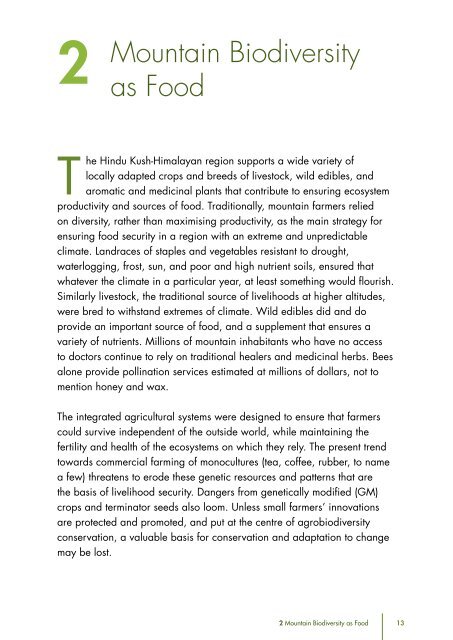Mountain Biodiversity of the Hindu Kush-Himalayas - Himalayan ...
Mountain Biodiversity of the Hindu Kush-Himalayas - Himalayan ...
Mountain Biodiversity of the Hindu Kush-Himalayas - Himalayan ...
You also want an ePaper? Increase the reach of your titles
YUMPU automatically turns print PDFs into web optimized ePapers that Google loves.
1 <strong>Mountain</strong> Flora and Fauna<br />
2<br />
<strong>Mountain</strong> <strong>Biodiversity</strong><br />
as Food<br />
The <strong>Hindu</strong> <strong>Kush</strong>-<strong>Himalayan</strong> region supports a wide variety <strong>of</strong><br />
locally adapted crops and breeds <strong>of</strong> livestock, wild edibles, and<br />
aromatic and medicinal plants that contribute to ensuring ecosystem<br />
productivity and sources <strong>of</strong> food. Traditionally, mountain farmers relied<br />
on diversity, ra<strong>the</strong>r than maximising productivity, as <strong>the</strong> main strategy for<br />
ensuring food security in a region with an extreme and unpredictable<br />
climate. Landraces <strong>of</strong> staples and vegetables resistant to drought,<br />
waterlogging, frost, sun, and poor and high nutrient soils, ensured that<br />
whatever <strong>the</strong> climate in a particular year, at least something would flourish.<br />
Similarly livestock, <strong>the</strong> traditional source <strong>of</strong> livelihoods at higher altitudes,<br />
were bred to withstand extremes <strong>of</strong> climate. Wild edibles did and do<br />
provide an important source <strong>of</strong> food, and a supplement that ensures a<br />
variety <strong>of</strong> nutrients. Millions <strong>of</strong> mountain inhabitants who have no access<br />
to doctors continue to rely on traditional healers and medicinal herbs. Bees<br />
alone provide pollination services estimated at millions <strong>of</strong> dollars, not to<br />
mention honey and wax.<br />
The integrated agricultural systems were designed to ensure that farmers<br />
could survive independent <strong>of</strong> <strong>the</strong> outside world, while maintaining <strong>the</strong><br />
fertility and health <strong>of</strong> <strong>the</strong> ecosystems on which <strong>the</strong>y rely. The present trend<br />
towards commercial farming <strong>of</strong> monocultures (tea, c<strong>of</strong>fee, rubber, to name<br />
a few) threatens to erode <strong>the</strong>se genetic resources and patterns that are<br />
<strong>the</strong> basis <strong>of</strong> livelihood security. Dangers from genetically modified (GM)<br />
crops and terminator seeds also loom. Unless small farmers’ innovations<br />
are protected and promoted, and put at <strong>the</strong> centre <strong>of</strong> agrobiodiversity<br />
conservation, a valuable basis for conservation and adaptation to change<br />
may be lost.<br />
2 <strong>Mountain</strong> <strong>Biodiversity</strong> as Food<br />
13
















